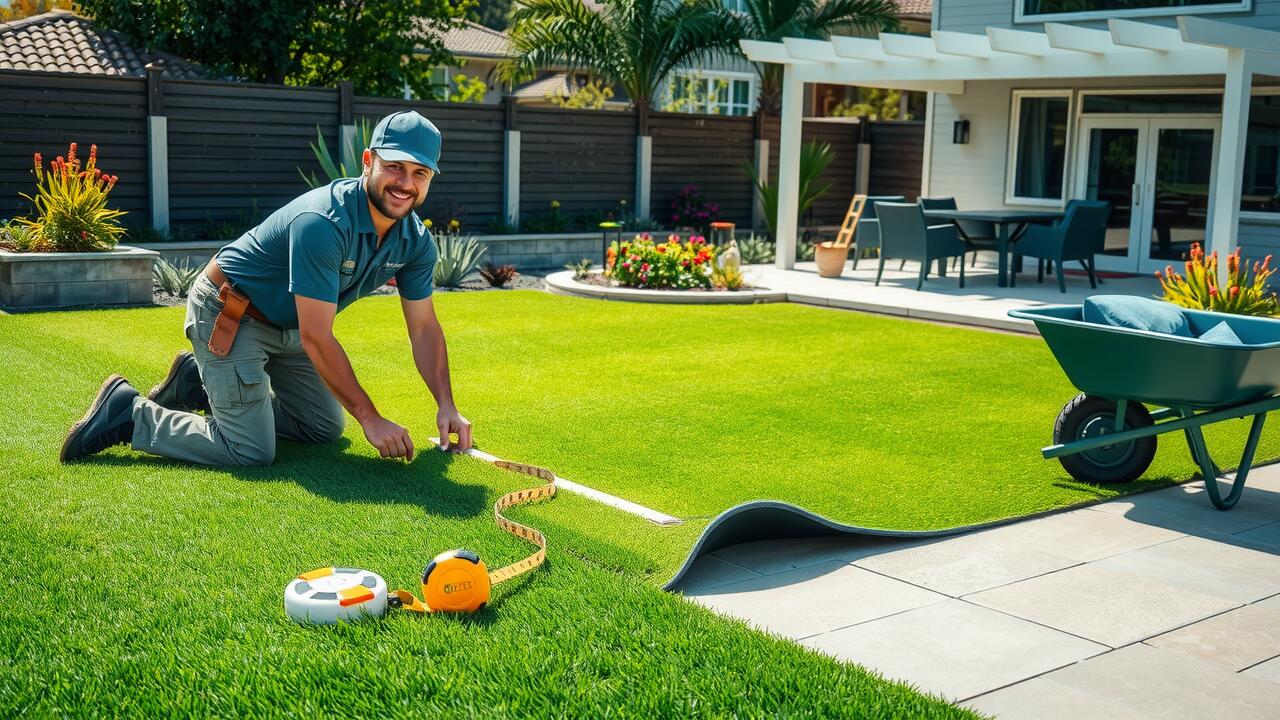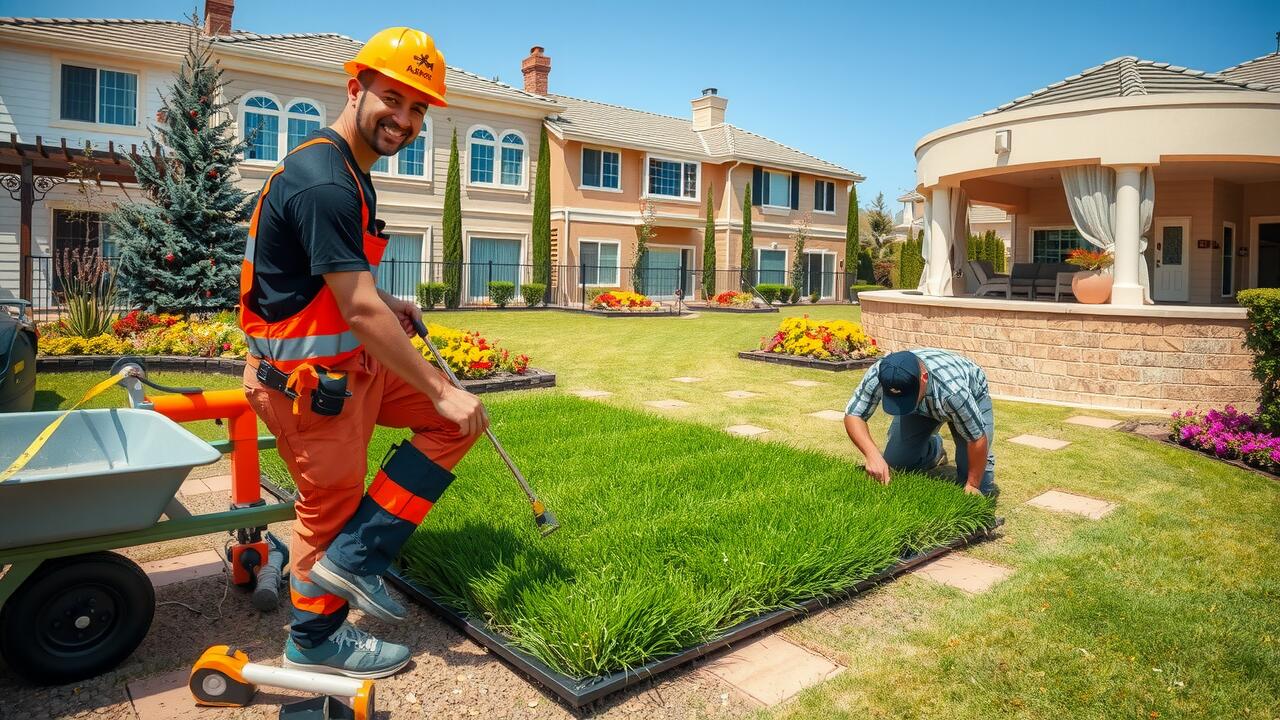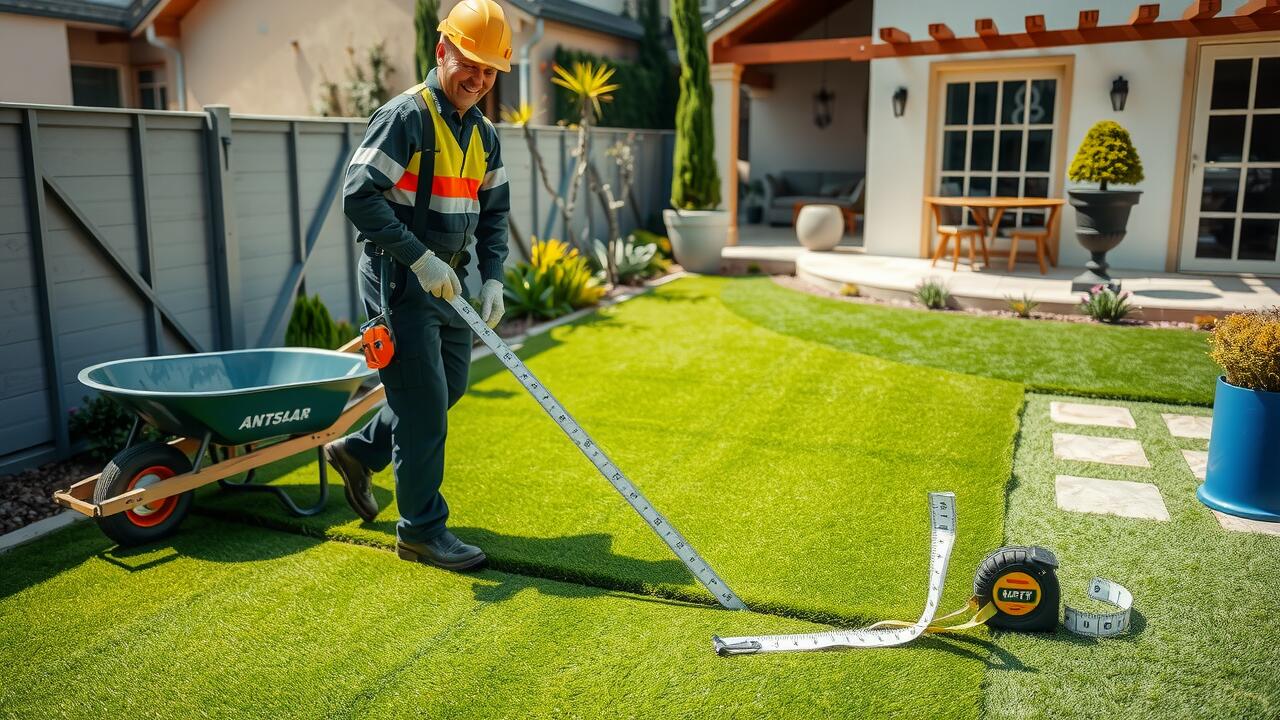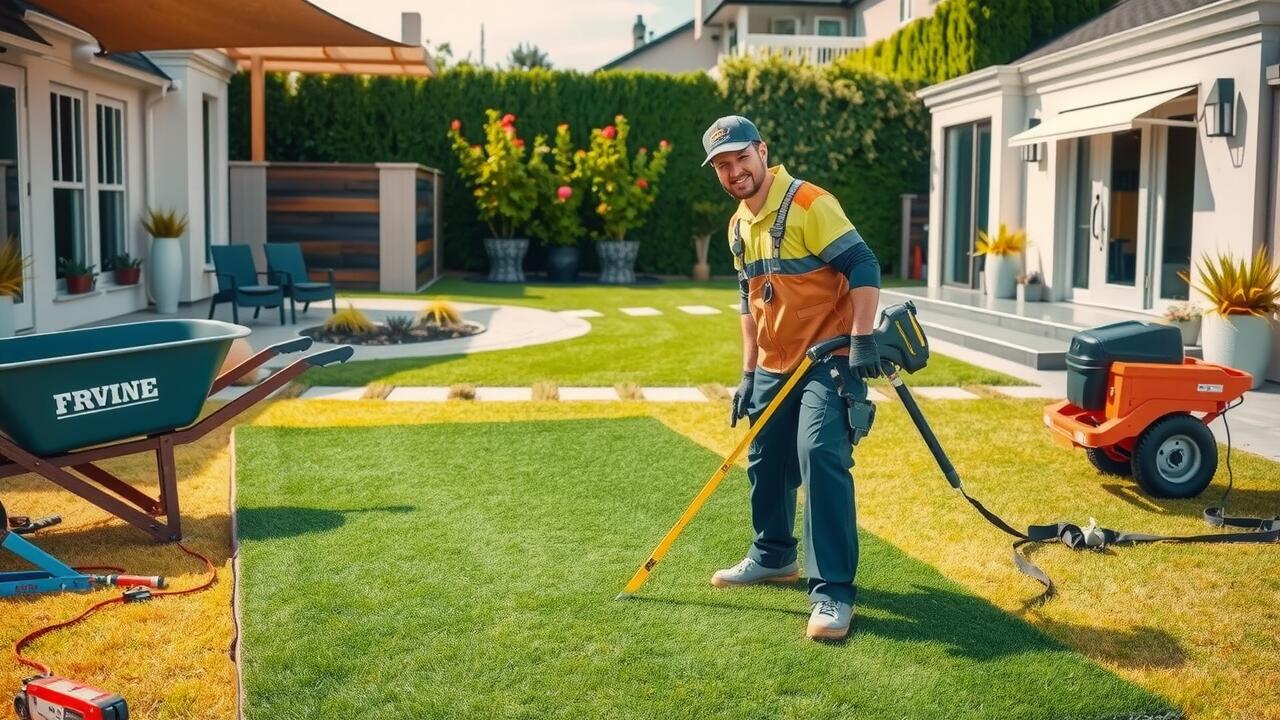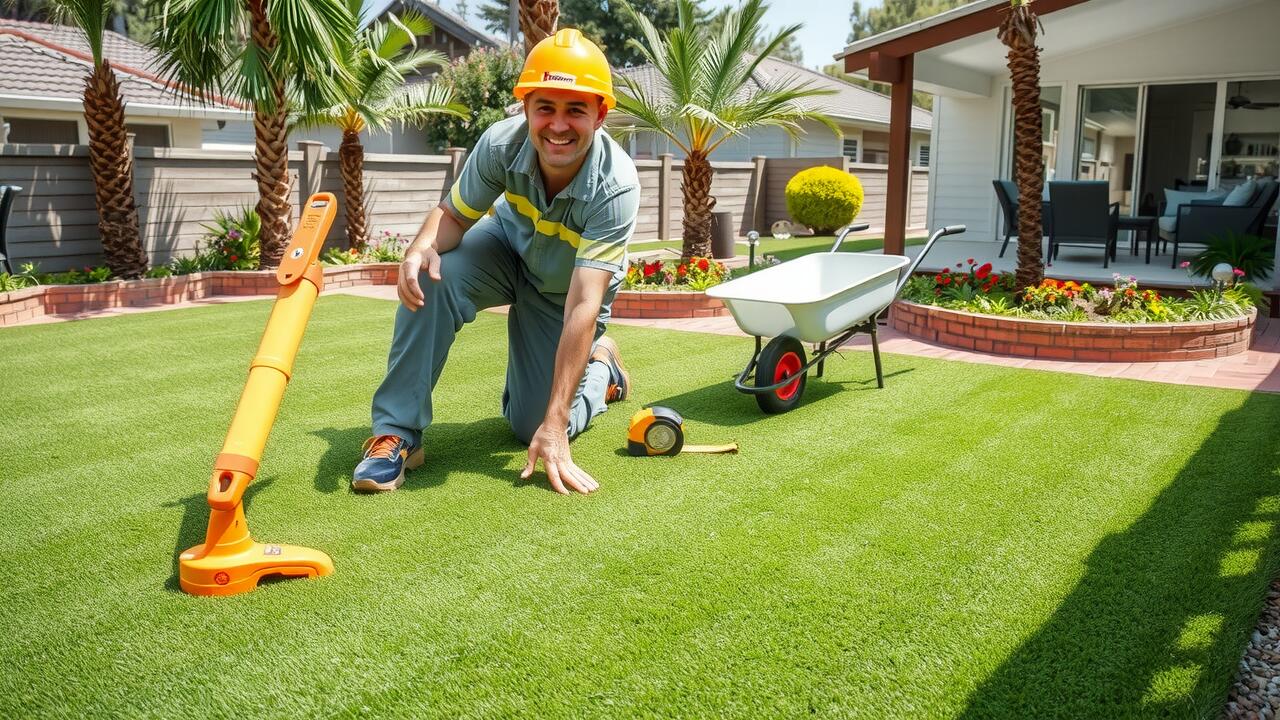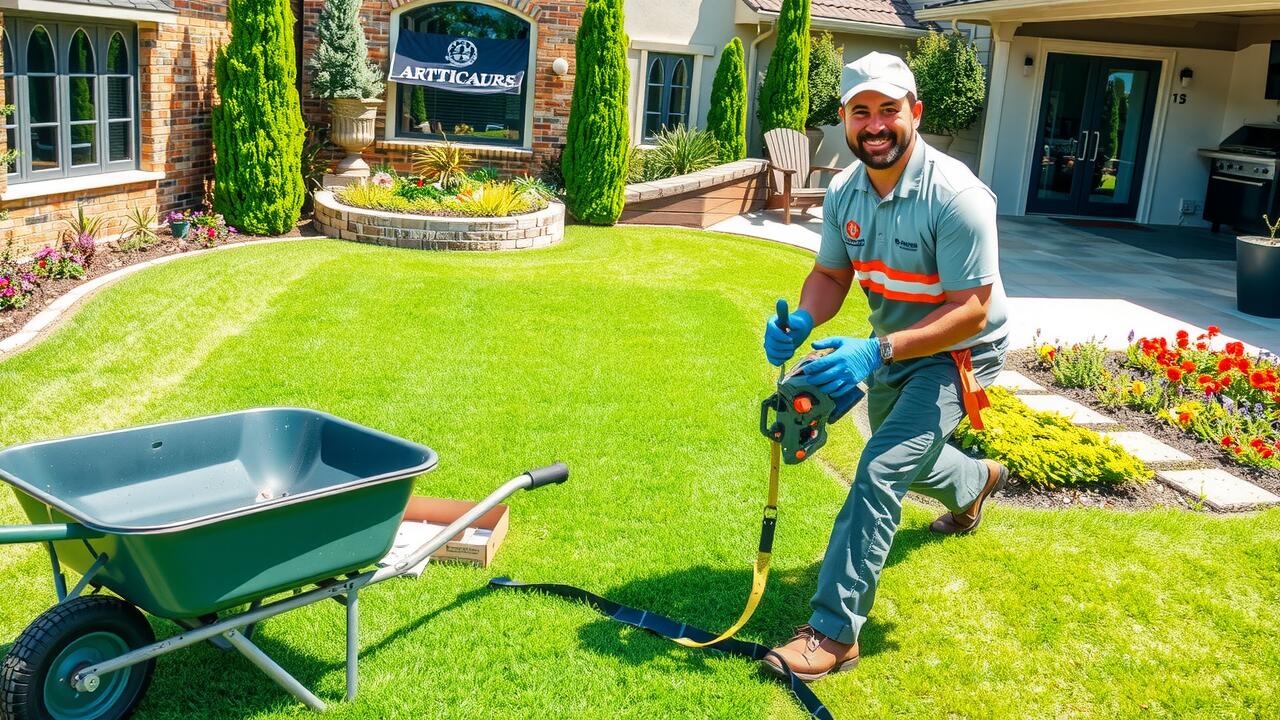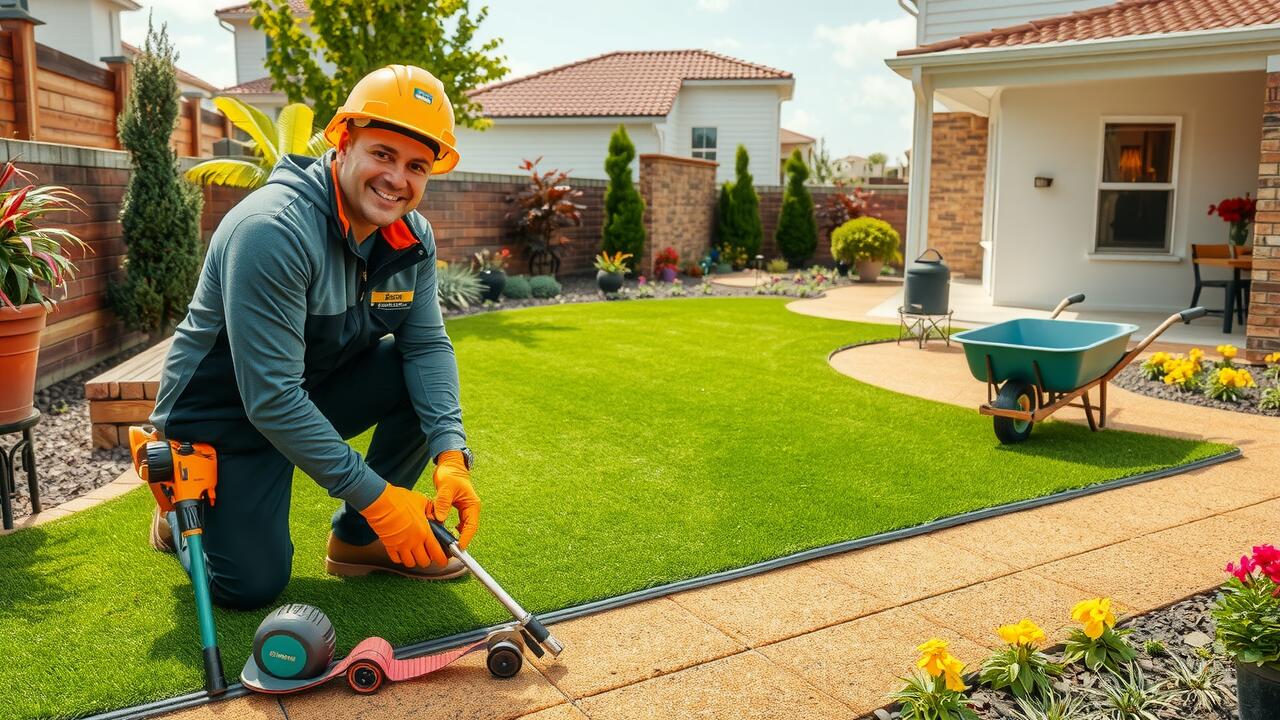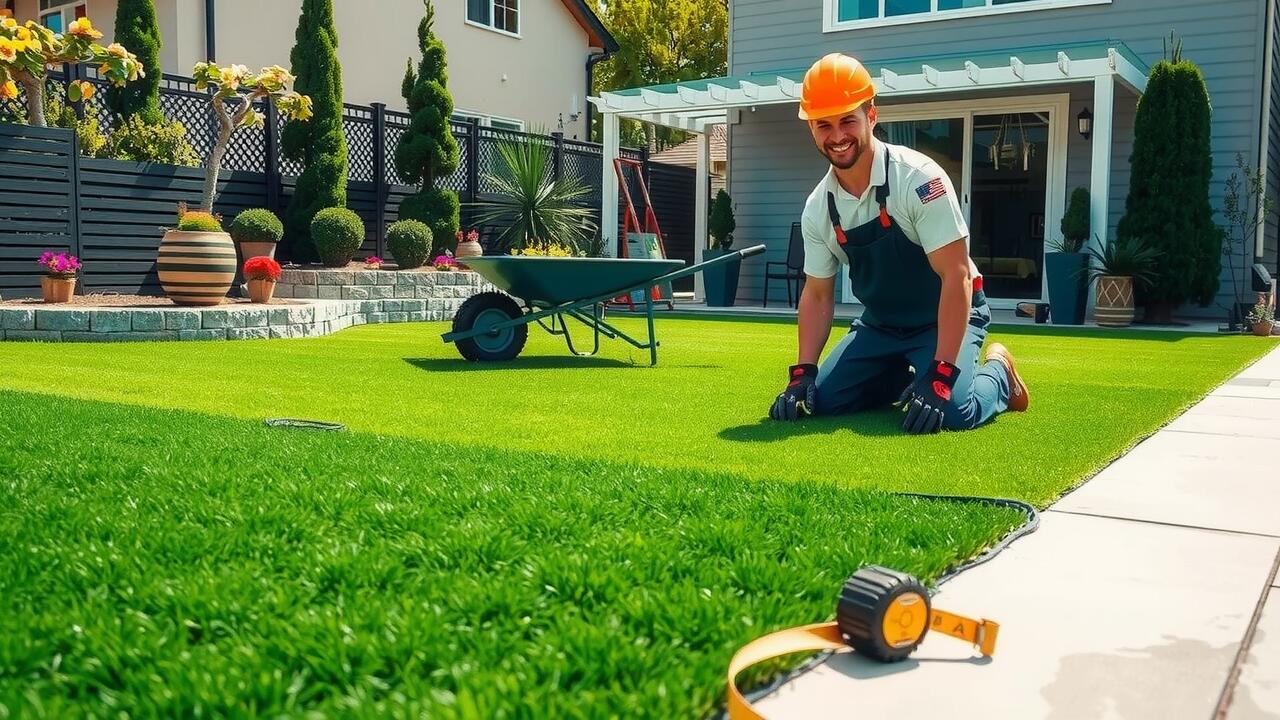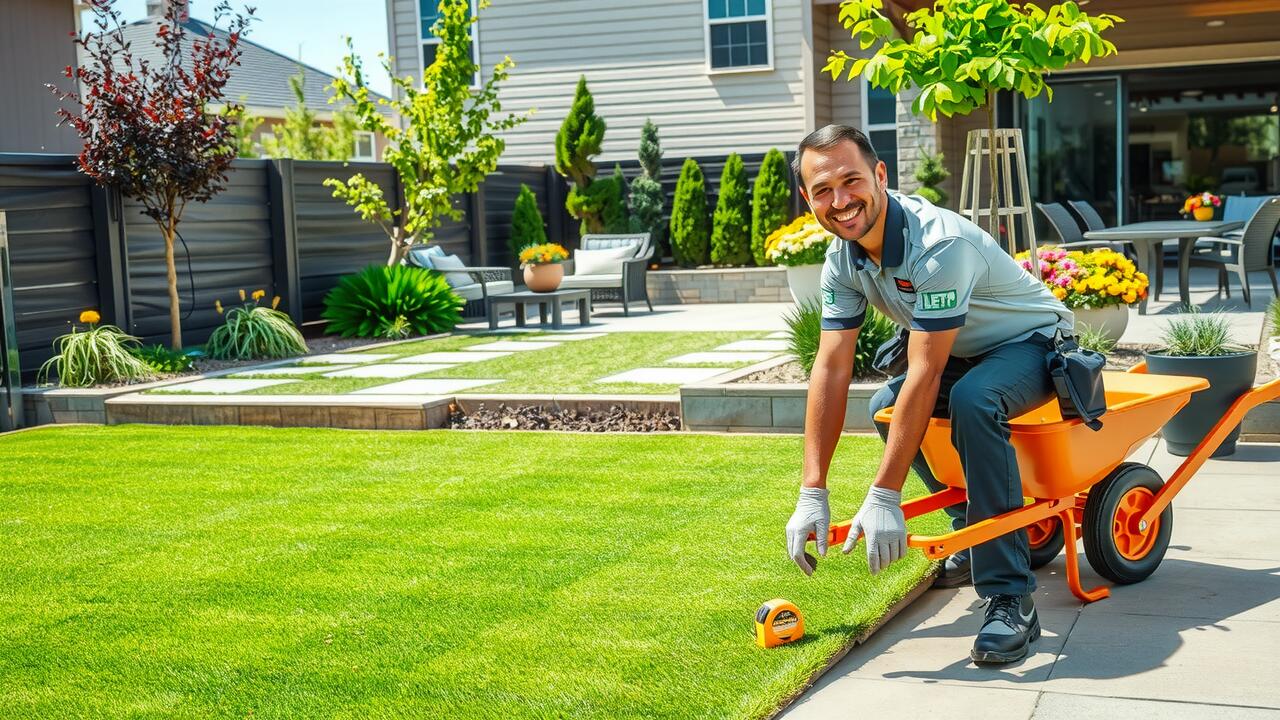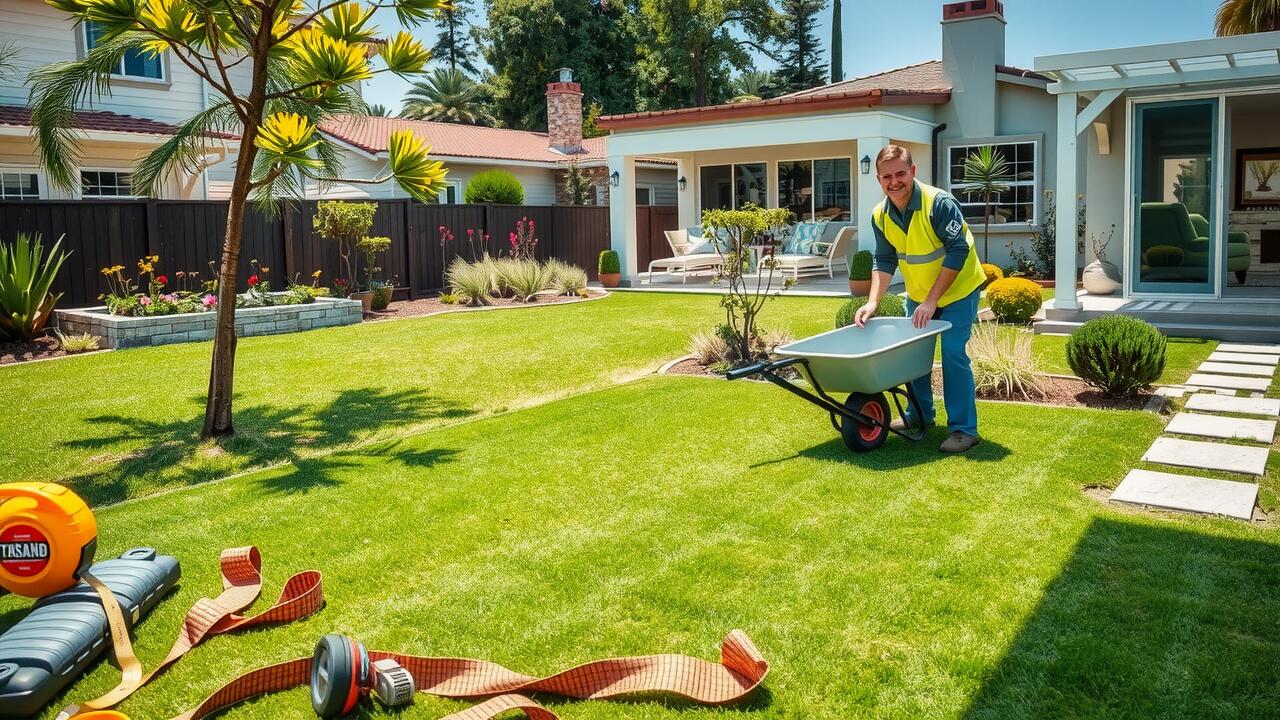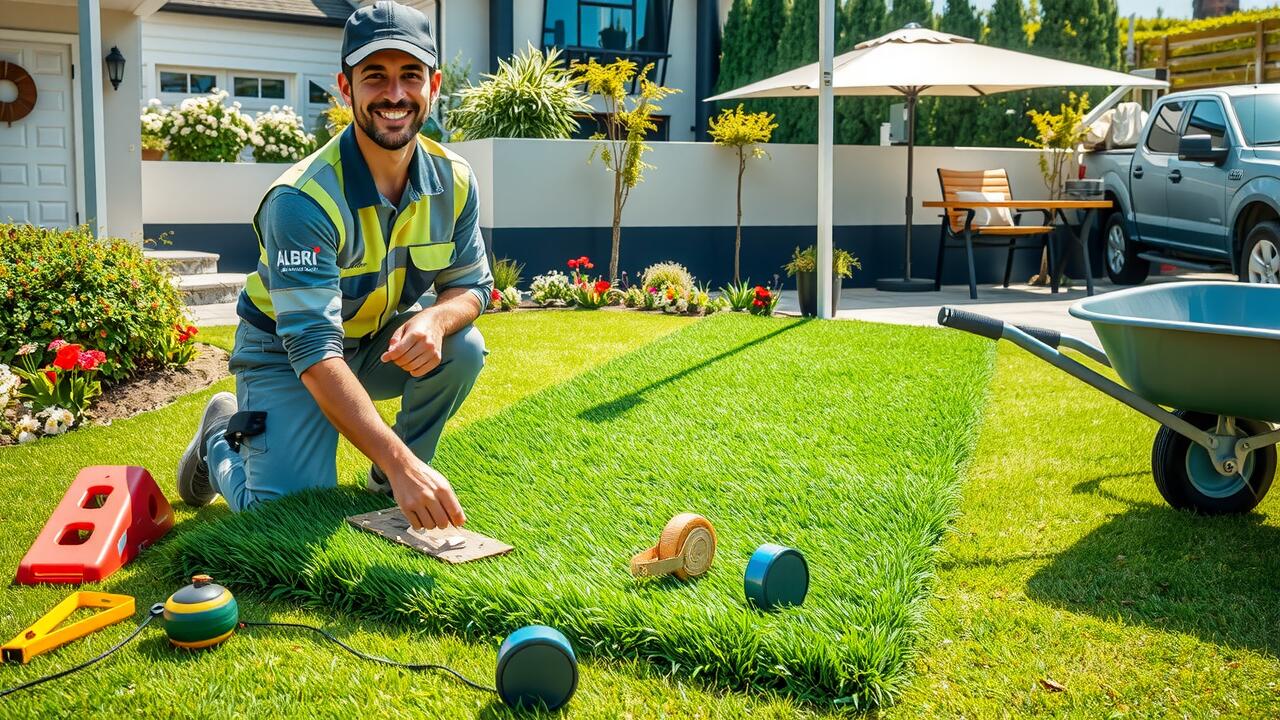Category: Uncategorized
Decomposed Granite as a Low-Cost Alternative
Decomposed granite has emerged as a popular low-cost alternative for those looking to install artificial turf. This material consists of weathered granite that breaks down into small particles, providing a solid and stable base for turf. Its natural composition allows for effective drainage, which is crucial in maintaining the longevity of artificial grass. Additionally, decomposed granite is widely accessible and typically less expensive than other base materials, making it an attractive option for budget-conscious homeowners.
Using decomposed granite as a sub-base can enhance the performance of artificial turf by creating a level surface that supports the turf’s weight and reduces moisture buildup. The natural material permits good airflow and limits the risk of weeds penetrating through the turf. However, proper installation and compaction are essential to ensure it performs optimally. This attention to detail can lead to a more durable and aesthetically pleasing artificial grass installation.
Characteristics and Uses
Decomposed granite is characterized by its fine texture and ability to compact well, making it an effective sub-base material for various surfaces, including artificial turf. This natural product consists of weathered granite that breaks down into smaller particles, providing excellent drainage and stability. Its composition allows it to support foot traffic while ensuring that the turf remains well-aerated and prevents water pooling.
In terms of uses, decomposed granite is not limited to just landscaping; it is also popular in playgrounds and pathways. Its affordability makes it accessible for those looking to install artificial turf without incurring high costs. Additionally, the material can be easily shaped and molded, lending itself to creative designs and applications in various outdoor spaces.
Sand as a Sub-Base Material
Sand has emerged as a popular choice for sub-base material beneath artificial turf, primarily due to its availability and cost-effectiveness. It provides a solid foundation that helps with drainage while maintaining a level surface. Proper installation techniques, such as compacting the sand evenly, can enhance its effectiveness. Sand can easily adapt to different terrains, making it suitable for various applications, whether for residential lawns or commercial landscapes.
Despite its benefits, sand does have limitations when used as a sub-base for artificial turf. It may shift over time, leading to uneven surfaces and potential maintenance issues. Additionally, sand can compact, which might impede drainage if not properly maintained. Understanding these factors is crucial for anyone considering sand as a sub-base material for their artificial turf installation to ensure longevity and performance.
Advantages and Limitations
Sand serves as an effective sub-base material for artificial turf due to its affordability and availability. Its fine texture allows for proper drainage, reducing the risk of water pooling on the surface. This property makes it particularly appealing for regions that experience significant rainfall. Additionally, sand is easy to work with, requiring minimal equipment and labor, which further lowers installation costs.
However, there are limitations to using sand as a sub-base for artificial turf. Over time, sand can shift and compact, potentially leading to uneven surfaces that may require repairs or adjustments. It may also settle under heavy foot traffic, which could impair the performance of the artificial turf. Furthermore, its lightweight nature can make it susceptible to erosion in windy conditions, especially without proper containment measures in place.
Comparing Natural vs. Synthetic Sub-Bases
When evaluating natural and synthetic sub-bases for artificial turf, several factors come into play. Natural sub-bases, such as decomposed granite and sand, are often economical and environmentally friendly options. They can provide adequate drainage and stability, which are essential for the longevity of the turf. However, these materials might require more maintenance over time, as they can be susceptible to erosion or compaction.
On the other hand, synthetic sub-bases offer specific advantages tailored for artificial turf installations. These materials are engineered to provide consistent performance, ensuring a stable surface that minimizes settling or shifting. While the initial cost may be higher, the durability and low maintenance associated with synthetic options can result in savings in the long run, making them an attractive consideration for many installations.
Cost Implications of Each Type
When evaluating the cost implications of sub-base materials for artificial turf, it’s essential to consider both initial expenses and long-term maintenance costs. Decomposed granite tends to be one of the more economical options upfront. Its low cost can be attributed to its natural abundance and ease of installation. However, while it may save money initially, its durability and drainage capabilities can impact overall costs in the long run if repairs or replacements are needed.
On the other hand, sand as a sub-base material presents a different cost scenario. Although sand can be relatively inexpensive, the need for higher quality sand that provides adequate drainage and stability increases expenses. Sand can shift over time, which may necessitate more frequent grooming and maintenance. This can lead to added labor costs. Thus, professionals often weigh the initial investment against potential future maintenance when choosing the right sub-base for artificial turf.
FAQS
What is a sub-base for artificial grass?
A sub-base for artificial grass is the layer of material that lies beneath the grass installation. It provides stability, drainage, and support to the artificial grass, ensuring that it maintains its structure and aesthetic appeal.
Why is decomposed granite considered a low-cost alternative for a sub-base?
Decomposed granite is often more affordable than other sub-base materials due to its natural availability and ease of installation. It compacts well, providing a stable foundation while also allowing for effective drainage.
What are the advantages of using sand as a sub-base material?
Sand provides excellent drainage, is lightweight, and is easy to work with during installation. It can also help with leveling the ground, making it a good choice for certain applications.
Are there any limitations to using natural sub-bases compared to synthetic ones?
Yes, natural sub-bases may have limitations such as inconsistent compaction, potential for erosion, and varying costs depending on local availability. Synthetic sub-bases can offer more uniformity and durability but may come at a higher price.
How do cost implications vary between natural and synthetic sub-bases?
Natural sub-bases like decomposed granite and sand are generally more cost-effective, while synthetic sub-bases can be more expensive due to manufacturing and material costs. It’s essential to weigh the long-term benefits and maintenance needs when considering your budget.
Laying the Artificial Turf
To begin laying artificial turf, start with preparing the ground effectively. Clear the area of any debris, rocks, and old grass. Ensure that the ground has proper drainage to avoid water pooling, which can damage the turf over time. Use a rake to level the soil, creating a smooth surface for the artificial turf to rest on. Adding a layer of crushed gravel or sand helps in drainage as well as providing a stable base.
Once the ground is ready, roll out the artificial turf, allowing it to acclimate to the temperature. Cut the turf to fit the designated space using a sharp utility knife. It’s essential to ensure that the edges align properly for a clean look. Use infill material to weight the edges and help the turf stand upright, mimicking the natural grass experience. Taking these steps will aid in achieving a professional finish for your artificial turf project.
Techniques for Seamless Installation
When working with artificial turf, achieving a seamless installation begins with proper preparation of the base. Ensure the ground is clear of any debris, rocks, or vegetation. A well-leveled base enhances drainage and prevents uneven surfaces, which can affect the overall appearance and functionality of the turf. Use a compactor to create a solid foundation, and consider adding a layer of crushed stone or gravel for optimal drainage.
Once the base is ready, carefully roll out the artificial turf, allowing it to acclimate to the environment. This step minimizes wrinkles and creases. Make precise cuts at the seams to align the edges perfectly, ensuring a natural look. Utilizing adhesive or seam tape helps secure the joints effectively. Pay attention to the orientation of the turf fibers during installation to maintain a uniform appearance across the entire surface.
Securing the Turf Properly
Securing the turf properly is crucial for ensuring a stable and long-lasting installation. Begin by laying the artificial turf in its desired position. Use landscape staples or U-shaped pins to anchor the edges into the ground, spacing them about every 6 to 12 inches. This step prevents the turf from shifting over time and helps maintain its appearance. Ensure the staples penetrate the backing of the turf fully for optimal grip.
Additionally, consider using adhesive or seam tape for areas where two pieces of artificial turf meet. This can create a seamless look and provide extra security against separation. For larger installations, perimeter edging can also be beneficial. It acts as a barrier to keep the turf firmly in place and minimizes the risk of displacement due to foot traffic or weather conditions. Overall, taking these measures will enhance the durability of your artificial turf.
Methods to Keep Turf in Place
Securing artificial turf effectively requires a combination of proper techniques and materials. Start by ensuring the ground underneath is level and well-drained to prevent shifting. Use landscape pins or stakes around the perimeter of the turf to anchor it firmly in place. Placing these pins every few feet, particularly in corners and along edges, will help maintain the integrity of your installation.
In addition to using pins, applying infill material can further stabilize artificial turf. This infill, typically made of sand or rubber, adds weight and helps to keep the grass blades upright. Distributing the infill evenly across the surface not only improves the look of your artificial turf but also enhances its performance. Regularly checking and replenishing the infill will help maintain the turf’s structure and appearance over time.
Maintaining Your Artificial Turf
Regular maintenance is essential for preserving the appearance and functionality of your artificial turf. Begin by removing debris such as leaves, sticks, and dirt using a leaf blower or a rake. Occasional brushing with a broom can also help lift the blades and maintain their upright position, preventing matting. It is important to rinse the surface with water to eliminate dust and allergens, especially in dry conditions.
Inspecting your artificial turf for any signs of wear and damage should be part of your routine. Look for loose seams, lifted edges, or fading colors, as these issues can affect the overall aesthetic and usability. Addressing minor repairs promptly can prevent further deterioration. Additionally, applying infill material may stabilize the turf and provide cushioning, enhancing its longevity. Regular upkeep will ensure your artificial turf remains inviting and functional for years to come.
Best Practices for Longevity
To ensure the longevity of artificial turf, regular maintenance is essential. This includes periodic brushing to keep the fibers upright and prevent matting. Rinsing the surface with a hose can remove dust, debris, and pet waste. Regular cleaning prevents buildup that could deteriorate the turf’s appearance and functionality over time.
Using a mulch or infill material can also enhance the performance of artificial turf. This helps with weight distribution and provides additional stability. In addition, maintaining proper drainage is crucial to avoid pooling water. Following these best practices will keep your artificial turf looking vibrant and functional for many years.
FAQS
Can I install artificial turf myself, or should I hire a professional?
Yes, you can install artificial turf yourself if you have the right tools and follow proper installation techniques. However, hiring a professional may ensure a more polished finish and save time.
What tools do I need to install artificial turf?
The essential tools for installing artificial turf include a utility knife, turf staples or adhesive, a broom, a turf roller, and a compactor for the base material.
How long does it typically take to install artificial turf?
The installation time can vary based on the size of the area, but it generally takes one to three days for most DIY projects, depending on preparation and weather conditions.
What is the best way to prepare the ground before laying artificial turf?
The ground should be cleared of debris, leveled, and compacted. It’s also important to install a proper drainage system and a weed barrier to prevent future issues.
How can I ensure my artificial turf stays in place?
To secure your artificial turf, you can use turf staples or adhesive, as well as properly weighted infill materials. Ensuring that the edges are secured and that the turf is laid flat will also help keep it in place.
Water Usage
Water usage has become a significant concern for many homeowners when considering landscaping options. Traditional natural grass lawns require substantial amounts of water for maintenance, especially during warmer months. In contrast, artificial turf eliminates the need for frequent irrigation, resulting in water conservation benefits. This aspect makes artificial grass an appealing choice, particularly in regions prone to drought.
Despite the water-saving advantages, some argue that artificial turf presents environmental challenges. While it reduces water consumption, it does not support local ecosystems or contribute to soil health like real grass does. Homeowners must weigh these factors carefully. The decision often hinges on personal priorities, including water usage versus ecological impact.
Comparison with Natural Grass
Artificial turf has gained popularity in recent years, but many homeowners still find natural grass to be superior in several aspects. Natural grass offers a softness that provides a more inviting surface for both leisure and play. The scent of freshly cut grass brings a sensory experience that artificial surfaces simply cannot replicate. Additionally, natural grass contributes to local ecosystems by supporting insects and small animals, enhancing biodiversity in residential areas.
On the other hand, artificial turf may seem appealing due to its low maintenance requirements and resilience against wear and tear. While it doesn’t require mowing, watering, or fertilization, its long-term environmental impact is a concern. The heat retention of artificial surfaces can lead to higher temperatures in outdoor spaces, which might detract from the enjoyment of a garden or yard. This often leads to a preference for the more natural aesthetics and ecological benefits that come with maintaining a healthy lawn of natural grass.
Cost Considerations
The initial installation cost of artificial turf can be significant. Homeowners often pay a premium for materials and labor, which can be seen as an investment. However, this upfront expense may not always lead to long-term savings. Maintenance costs then become a point of analysis; while artificial grass typically requires less ongoing care than natural grass, the specialized cleaning products and occasional need for replacement or repairs can add up over time.
In comparing financial implications, property owners weigh the benefits against potential hidden costs. Some find that the lack of natural drainage can lead to problems with water accumulation, prompting further spending on additional drainage systems. Additionally, the aesthetic aspect can diminish over time, which may lead people to ultimately replace the turf, leading to further expenses. The initial allure of artificial turf may fade when considering these financial aspects, prompting many to reconsider their choices.
Financial Implications Over Time
The initial investment in artificial turf can be substantial, often costing homeowners thousands of dollars per installation. While many believe this cost will be offset by savings on water and maintenance, the reality is more complex. Regular cleaning, infrequent replacements, and potential repairs can accumulate over time, impacting the overall financial outlook. In some cases, homeowners may find that these ongoing costs reduce the perceived benefits of a one-time purchase.
Moreover, the long-term durability of artificial turf is not guaranteed. Environmental factors such as UV exposure, wear from foot traffic, and local climate can significantly affect its lifespan. Homeowners may need to factor in the possibility of replacement or significant repairs within a decade, potentially leading to higher expenses than anticipated. Such considerations play a crucial role in understanding the financial implications over time associated with choosing artificial turf.
User Experience
Homeowners and residents often report mixed feelings about the experience of having artificial turf. While it eliminates the need for mowing and extensive maintenance, some find it lacks the natural feel and aesthetic of real grass. Many users express that during hot weather, the artificial surface can become uncomfortably warm, making it less enjoyable for family activities or pets. This raises questions about its suitability for everyday use, particularly in regions with high summer temperatures.
Feedback regarding the visual appeal of artificial turf also varies. Some appreciate its always-green look, viewing it as a year-round solution for landscaping. Others argue that it can appear unnatural, especially up close, and doesn’t integrate well with traditional gardens. As homeowners weigh the benefits against the drawbacks, the overall user experience plays a significant role in their decision to keep or remove artificial turf.
Feedback from Homeowners and Residents
Homeowners and residents have voiced a mix of opinions regarding artificial turf. Many appreciate its low maintenance requirements and the ability to maintain a consistently green lawn year-round. However, some express concerns about the feel of artificial grass underfoot, finding it less pleasant than natural grass. This tactile difference can influence overall satisfaction, especially for families with children who enjoy playing outdoors.
Additionally, homeowners have reported varying experiences with heat retention on artificial turf. While some find that the surface remains comfortable for casual use, others note that it can become uncomfortably hot during the summer months. This feedback highlights the importance of considering local climate conditions when deciding whether to use artificial turf and suggests that not all homeowners may achieve the same level of enjoyment or practicality.
FAQS
Why are people choosing to remove artificial grass?
Many people are removing artificial grass due to concerns about water drainage, heat retention, and the environmental impact it may have compared to natural grass.
How does water usage differ between artificial grass and natural grass?
Artificial grass typically requires less water for maintenance compared to natural grass, but issues with drainage and moisture retention can arise, leading some to prefer natural alternatives for better ecosystem health.
What are the financial implications of keeping artificial grass?
While artificial grass might save on water and maintenance in the short term, the initial installation cost can be high, and some homeowners find that over time, natural grass may be more cost-effective due to lower replacement and repair needs.
What feedback have homeowners provided about their experience with artificial grass?
Feedback from homeowners varies; some enjoy the low maintenance aspect, while others report dissatisfaction with the heat retention, aesthetic differences from natural grass, and the feel underfoot.
Are there any environmental concerns associated with artificial grass?
Yes, there are concerns regarding the production and disposal of synthetic materials used in artificial grass, as well as the impact on local wildlife and soil health, prompting some to reconsider its use in favor of natural grass.
Maintenance Requirements
Artificial turf tends to require less regular maintenance compared to natural grass. Homeowners often find that they spend less time mowing, watering, and fertilizing when they opt for artificial surfaces. The consistent appearance of artificial turf means that it rarely requires reseeding or patching, allowing for a more uniform look year-round. Periodic brushing and occasional rinsing are typically sufficient to keep the surface looking clean and vibrant.
In contrast, natural grass demands ongoing attention to thrive. This includes regular mowing, watering based on the season, and applying fertilizers or pesticides to maintain health and appearance. These maintenance tasks can quickly accumulate in terms of time and expense, especially during periods of heavy growth. Ultimately, for those seeking a low-maintenance option, artificial turf presents a compelling alternative that simplifies outdoor upkeep.
Comparing Labor Needs
When evaluating labor needs for maintaining recreational areas, the differences between natural grass and artificial turf are significant. Natural grass requires regular mowing, weeding, and seasonal fertilization, which can demand considerable time and effort. Maintaining a lush, green lawn also involves addressing various challenges like pests and diseases, necessitating ongoing attention from homeowners or landscaping professionals.
In contrast, artificial turf offers a more straightforward maintenance process that reduces labor requirements. Owners can enjoy an aesthetically pleasing outdoor space without the need for mowing, watering, or frequent chemical applications. This lower maintenance level appeals to busy families or individuals looking for convenience and a more manageable outdoor environment.
Cost Analysis
The initial investment for artificial turf can appear attractive due to the lower maintenance costs associated with it. Homeowners often find that while the upfront cost is significant, they save money over time on watering, mowing, and fertilization. Many companies offer warranties that can extend the lifespan of the turf, further mitigating long-term expenses. It is crucial to conduct a thorough cost analysis, considering both installation and maintenance expenses in the short and long run.
When comparing artificial turf to natural grass, homeowners should also factor in the potential for water savings, especially in drought-prone areas. The lack of need for herbicides and pesticides reduces chemical costs and environmental impact as well. Additionally, the consistent appearance of artificial turf can enhance property value, adding an intangible benefit that should be included in overall cost considerations.
Long-Term Financial Considerations
When evaluating long-term financial considerations, artificial turf may seem like an attractive option due to its initial lower maintenance costs. Homeowners often overlook replacement costs associated with natural grass, such as reseeding or re-sodding. However, the longevity of artificial turf can lead to substantial savings over time, as it does not require regular watering, fertilization, or pesticides, reducing ongoing expenses.
Investing in high-quality artificial turf often comes with a higher upfront installation cost. This investment can pay off through reduced utility bills and maintenance efforts, which accumulate over the years. Comparatively, the need to frequently replace sections of natural grass, particularly in high-traffic areas, can contribute to increased costs that may outweigh the benefits of natural solutions. Careful financial planning allows families to see the full impact of their choices in both the short and long term.
Safety for Children and Pets
Ensuring a safe play environment for children and pets is a top priority for many homeowners. Traditional grass can harbor pesticides, allergens, and harmful insects. In contrast, artificial turf presents a cleaner alternative. Its surface is designed to resist pests and does not require harmful chemicals for maintenance. The material used often provides a soft landing for falls, reducing the risk of injury during play.
For pet owners, artificial turf offers a practical solution. It drains easily, allowing for quick clean-up after pets do their business. The fibers are typically made from non-toxic materials, ensuring that pets remain safe while enjoying their time outdoors. Additionally, the absence of mud means less mess tracked into the home, making both the lawn and indoor spaces cleaner and more enjoyable.
Non-Toxic Play Areas
Non-toxic play areas provide peace of mind for parents concerned about the safety of their children. Many synthetic products, including artificial turf, contain chemicals that can pose health risks, especially for young, sensitive bodies. Opting for organic or natural alternatives ensures that kids can enjoy their playtime without exposure to harmful substances. These natural surfaces often come from renewable resources, minimizing environmental impact while promoting a healthier play environment.
Pets also benefit from non-toxic play areas. Traditional artificial turf can retain heat and, during hot weather, may lead to overheating or discomfort for animals. In contrast, natural options are breathable, providing a safer, cooler space for pets to run and play. Choosing materials free from harmful chemicals fosters a healthier environment for all family members, ensuring that both children and pets can enjoy their time outdoors with reduced risk of exposure to toxic substances.
FAQS
What are some alternatives to artificial turf?
Some alternatives to artificial turf include natural grass, mulch, stone, and native landscaping. Each option has its own benefits and drawbacks depending on maintenance, cost, and aesthetic preferences.
How does maintenance for natural grass compare to artificial turf?
Natural grass typically requires more maintenance than artificial turf, including regular mowing, watering, and fertilizing, while artificial turf needs less upkeep but requires occasional cleaning and infrequent infill replacement.
Is natural grass more cost-effective in the long run compared to artificial turf?
While artificial turf has a higher initial installation cost, natural grass can incur ongoing costs for maintenance, water, and fertilizers. Over time, the overall cost-effectiveness can vary based on local conditions and maintenance practices.
Are there safety concerns with natural grass for children and pets?
Natural grass can provide a safer play area for children and pets when it is free from pesticides and chemicals. It also has natural cushioning properties that can reduce the risk of injuries compared to harder surfaces.
What should I consider when choosing between artificial turf and natural alternatives?
Consider factors such as maintenance requirements, cost, safety for children and pets, environmental impact, and aesthetic preferences when deciding between artificial turf and natural alternatives.
Maintenance Challenges
Maintaining artificial turf presents unique challenges that can impact its longevity and performance. One major consideration is the need for regular cleaning. Unlike natural grass, artificial surfaces can accumulate dirt, debris, and even organic matter, which can affect their appearance and playability. A thorough cleaning regimen is essential to prevent build-up and maintain an inviting surface for users.
Another aspect of maintenance involves periodic checks for damage. While artificial turf is designed to withstand heavy use, wear and tear can occur over time. This includes issues like seam separation or damage from sharp objects. Addressing these problems promptly is crucial to ensure the turf remains safe and functional. Additionally, some facilities may require specialized equipment for repairs, adding to the overall maintenance burden associated with artificial turf.
Cleaning and Upkeep Requirements
Cleaning and upkeep requirements for artificial turf can be more demanding than many homeowners anticipate. While it may seem like a low-maintenance option initially, regular cleaning is necessary to ensure the surface remains safe and visually appealing. Debris such as leaves, dirt, and pet waste can accumulate on the turf, necessitating periodic raking or brushing to prevent matting. Additionally, washing the turf with water helps remove odors and other contaminants, promoting a healthier environment for users.
Maintaining the infill material is also critical for the longevity of artificial turf. Over time, the infill can become compacted or uneven, requiring occasional redistribution or replacement. Special care must be taken to avoid using harsh chemicals that might damage the fibers or degrade the infill. Homeowners and facilities must commit to these upkeep tasks to fully enjoy the benefits of artificial turf while preventing deterioration and ensuring optimal performance.
Wildlife Disruption
Artificial turf can significantly alter local ecosystems and disrupt wildlife habitats. Natural grass provides essential cover and food sources for various species, from insects to small mammals. The installation of artificial turf replaces these organic environments with synthetic materials, which do not support the same biodiversity. As a result, local animals may find it harder to thrive, leading to a decline in certain species that rely on these ecosystems.
In addition to habitat loss, artificial turf can affect the behaviors of wildlife. Animals may be deterred from areas previously rich in flora and fauna, which disrupts their natural foraging and nesting patterns. Furthermore, the materials used in artificial turf can pose health risks to wildlife, as they may expose animals to toxins or cause injuries. The long-term implications for local ecosystems could include a reduction in species diversity and an imbalance in the local food chain.
Effects on Local Ecosystems
Artificial turf can significantly alter local ecosystems by disrupting natural habitats. When synthetic surfaces replace grass, the biodiversity of flora and fauna may decline. Native plant species often struggle to thrive in the presence of artificial materials, and organisms that depend on these plants for food or shelter may be adversely affected. Birds, insects, and small mammals could find it difficult to navigate or adapt to the altered landscape, leading to potential imbalances in local populations.
In addition to impacting terrestrial habitats, artificial turf can affect water ecosystems through runoff. Rainwater that flows over synthetic surfaces can carry pollutants and chemicals that accumulate over time. This pollution can enter nearby streams, rivers, and lakes, harming aquatic life and altering water quality. Therefore, while artificial turf offers some practical benefits, its impact on local ecosystems raises significant environmental concerns that merit consideration.
Costs of Installation
The initial costs of installing artificial turf can be significantly higher than those associated with natural grass. Homeowners and facility managers might find the upfront expenses daunting, as materials and labor for installation contribute to a substantial investment. Depending on the quality of turf and the size of the area being covered, prices can range widely, leaving many to weigh the benefits against the financial commitment.
Over time, the financial implications of artificial turf may extend beyond the initial installation. While maintenance costs can be lower than those for natural grass, there are still ongoing expenses related to cleaning, repairs, and the potential need for infill material replacement. Additionally, the long-term durability of artificial turf can influence its cost-effectiveness, as some lower-quality options might require replacement sooner than anticipated. This creates a complex financial landscape that potential buyers need to consider carefully.
Financial Considerations Over Time
Artificial Turf typically represents a significant upfront investment compared to natural grass. The costs include not only the material itself but also the expenses associated with installation. Homeowners and municipalities must budget for these initial financial commitments, which can be quite substantial depending on the area being covered. Long-term value calculations may also vary based on how frequently the surface is used and maintained.
Over time, while maintenance expenses may be lower than those for natural grass, other costs can arise. Replacement of the turf can be necessary after several years due to wear and tear. Additionally, ongoing care, such as cleaning to prevent mildew and odors, can contribute to overall financial expenditure. Evaluating these factors is essential for anyone considering the switch to artificial turf, ensuring that the long-term implications are fully understood.
FAQS
What are the main maintenance challenges associated with artificial turf?
The primary maintenance challenges include regular cleaning to remove debris, addressing drainage issues, and ensuring the infill material remains evenly distributed to maintain the turf’s appearance and functionality.
How does artificial turf affect local wildlife?
Artificial turf can disrupt local ecosystems by altering habitats, reducing natural food sources, and potentially displacing wildlife that relies on natural grass areas for living and breeding.
What are the long-term financial considerations of installing artificial turf?
While the initial installation cost of artificial turf can be high, long-term savings may arise from reduced water usage, lower maintenance costs, and the elimination of pesticides and fertilizers. However, it’s essential to factor in potential replacement or repair costs over time.
Can artificial turf cause environmental issues?
Yes, artificial turf can lead to environmental issues such as heat retention, runoff of microplastics into waterways, and the creation of a synthetic environment that doesn’t support biodiversity compared to natural grass.
Is artificial turf safe for pets and children?
Generally, artificial turf is considered safe for pets and children, but it’s important to choose non-toxic materials and ensure proper maintenance to prevent the buildup of bacteria and odors. Regular cleaning can help maintain a safe environment.
Installation of Weed Barriers
When installing artificial turf, one crucial step is the addition of weed barriers. These barriers prevent unwanted vegetation from infiltrating the turf, which can compromise its appearance and integrity. A high-quality weed barrier fabric acts as a blockade, allowing for proper drainage while effectively suppressing the growth of weeds below the surface. Ensuring that this layer is installed correctly can enhance the longevity and aesthetic appeal of the artificial turf.
The selection of the appropriate weed barrier is essential. Some options are designed specifically for turf applications and offer added benefits such as UV resistance. Installing a weed barrier not only saves time and effort in maintenance but also fosters a cleaner, more attractive landscape. With the right measures in place, homeowners can enjoy the beauty of artificial turf without the distraction of persistent weeds.
Preventing Vegetation Growth Under Turf
To effectively prevent vegetation growth under artificial turf, the installation of a robust weed barrier is essential. This barrier acts as a physical block, preventing weeds and other unwanted plants from penetrating through the turf’s surface. Quality materials such as geotextiles can allow for water and nutrients to pass through while inhibiting root systems from taking hold. Ensuring the weed barrier is properly secured can prevent future maintenance issues and prolong the life of the artificial turf.
In addition to a weed barrier, the choice of infill material plays a critical role in suppressing plant growth. Some infill products come with built-in herbicidal properties, further reducing the chance of weeds establishing themselves beneath the artificial turf. Selecting the right combination of underlayment and infill helps maintain a clean and aesthetically pleasing surface while maximizing the turf’s performance. With these strategies in place, homeowners can enjoy a low-maintenance landscape without the hassle of persistent weeds.
Safety Considerations for Padding
When installing artificial turf, selecting the right padding is crucial for ensuring safety during use. Proper padding can help absorb shock and reduce the risk of injuries from falls, making it particularly important for areas with high foot traffic or where athletic activities take place. Materials such as foam or rubber are often chosen for their ability to cushion impacts effectively. Ensuring the padding meets industry standards can provide peace of mind for both installers and end users.
Another key consideration is the thickness and density of the padding. Insufficient padding can lead to a harder surface, increasing the chances of injury. Conversely, overly thick padding may affect the stability and performance of the artificial turf. Striking the right balance between comfort and functionality helps maintain a safe playing environment. Regular inspections can further ensure that the cushioning remains effective and in good condition throughout its lifespan.
Cushioning Materials to Reduce Injury Risk
Cushioning materials play a vital role in ensuring safety beneath artificial turf. They create a protective layer that absorbs impact during physical activities, significantly reducing the risk of injury from falls or other accidents. Common materials used for this purpose include foam pads, rubber mats, and shredded materials, which are engineered to provide both comfort and support. The selection of appropriate cushioning can enhance the user experience, making sporting activities safer for players of all ages.
In addition to minimizing injury risk, proper cushioning materials also contribute to the longevity of artificial turf. They help maintain the integrity of the turf over time by reducing wear and tear from frequent use. By providing a stable yet forgiving base, these materials can enhance performance and maintain playability, allowing athletes to perform at their best while enjoying the benefits of a safe playing surface.
The Role of Stability in Turf Longevity
Stability plays a crucial role in the longevity of artificial turf installations. The foundation upon which the turf is laid directly influences its performance and lifespan. An adequate base helps prevent sinking or shifting, which can lead to uneven surfaces. Stability ensures that the infill material remains in place, maintaining the desired look and functionality of the turf while also providing support for users.
The firmness of the underlying materials contributes to the effectiveness of the artificial turf system. Properly compacted base materials provide the necessary resilience to withstand foot traffic and environmental factors. A stable base minimizes the chances of wear and tear, reducing the need for frequent repairs or replacements. Ensuring that such stability is achieved can extend the life of artificial turf, making it a more cost-effective investment for both residential and commercial applications.
How Firmness Affects Performance
Firmness plays a crucial role in the performance of artificial turf, influencing how athletes interact with the surface during play. A well-firmed base allows for reliable traction, which is essential for sprinting, jumping, and direction changes. Inadequate firmness can lead to inconsistencies, increasing the risk of slips or falls. This affects not only performance but also the overall safety of users, as an unstable surface can contribute to injuries.
Moreover, the right level of firmness enhances the aesthetic appeal of artificial turf. A surface that provides a solid foundation preserves the pristine look of the fibers over time. Turf that is too soft may experience excessive wear and tear, leading to uneven patches or bald spots. Therefore, maintaining optimal firmness ensures athletes receive consistent performance while keeping the artificial turf looking its best throughout its lifespan.
FAQS
What is the purpose of installing a weed barrier underneath artificial turf?
A weed barrier helps prevent vegetation growth under the turf, ensuring that unwanted plants do not disrupt the appearance and functionality of the artificial grass.
What materials are commonly used for padding under artificial turf?
Common padding materials include foam, rubber, and other cushioning materials designed to reduce injury risk and provide comfort during use.
How does the firmness of the base affect the performance of artificial turf?
The firmness of the base impacts the stability and longevity of the turf, as it helps maintain the turf’s structure and can influence how well it performs during activities.
Can I install artificial turf directly on the soil without any additional materials?
It is not recommended to install artificial turf directly on soil, as it can lead to issues such as weed growth, uneven surfaces, and reduced longevity. Proper layers, including weed barriers and padding, should be used.
Is it necessary to use infill material under artificial turf, and what is its purpose?
Infill material is often used to provide weight, support the turf blades, and improve drainage. It can also enhance the overall feel and performance of the artificial turf.
Safety Features
Safety features play a crucial role in determining the appropriate surface for various applications, particularly for sports fields and playgrounds. Artificial turf is designed with advantages that can enhance safety. Many products incorporate shock-absorbing underlayers that minimize the risk of injury during falls. These innovative designs help create a softer landing surface, reducing the likelihood of serious injuries, making it an appealing choice for parents and sports facility managers alike.
In addition to shock absorption, the texture of artificial turf provides a consistent play surface. Unlike natural grass, which can become uneven or muddy, artificial turf maintains its integrity regardless of weather conditions. This stability helps to prevent tripping hazards when children or athletes are playing. Furthermore, many manufacturers treat their products with antimicrobial agents, reducing the risk of bacterial growth. These safety features ensure that artificial turf remains a safe option for recreational use throughout the year.
Injury Reduction and Surface Softness
Injury reduction is a crucial consideration when comparing turf and artificial grass. Artificial turf is often designed with advanced technology that enhances its safety features. Many products incorporate shock-absorbing materials that can minimize the impact of falls. This improved surface softness can be particularly beneficial for children and active individuals, providing a safer environment for play and sports activities.
The softness of artificial turf also contributes to overall comfort. This feature can be appealing for pet owners as well, as it offers a cushioned surface for animals to run and play on. Unlike some natural grasses that can become compacted or hard over time, artificial turf maintains its softness and resilience, promoting a more forgiving surface. Homeowners often prioritize these aspects when selecting their outdoor flooring options.
Installation Processes
The installation process for artificial turf presents a distinct set of steps compared to natural grass. Preparation of the ground is essential, requiring the removal of existing vegetation and debris. A base layer is typically added to ensure proper drainage and stability. Once the base is set, the turf is rolled out and cut to fit the designated area precisely. This process often involves securing the edges and seams to prevent any shifting over time.
Labor and time requirements can vary based on the size and complexity of the installation area. Generally, artificial turf installations take less time than laying natural sod, which requires a longer establishment period. Specialized equipment may be necessary to achieve optimal results, but many homeowners find that hiring professionals simplifies the process. While do-it-yourself options exist, the precision needed for a successful installation can make professional assistance more advantageous.
Labor and Time Requirements
The installation of artificial turf can vary significantly in terms of labor and time requirements. Typically, the process involves multiple stages, including site preparation, base installation, and the actual turf laying. Depending on the size of the area, the complexity of the installation, and the condition of the ground, homeowners might find themselves needing several days to complete the project. Professional installers often have the equipment and expertise to streamline this process, while DIY enthusiasts may face additional challenges that can extend the timeline.
In contrast, traditional grass may require a different approach concerning labor and maintenance. While it can involve a longer initial setup depending on landscaping needs, ongoing maintenance tasks such as mowing, watering, and fertilization add to the time investment. Artificial turf eliminates many of these recurring tasks, providing a lower-maintenance alternative once installed. The choice between the two often boils down to the willingness to invest time upfront against the long-term benefits of reduced upkeep.
User Experiences
Homeowners who have installed artificial turf often report a range of experiences that highlight its practicality. Many appreciate the low-maintenance nature of artificial grass, eliminating the need for mowing, watering, and dealing with pests. Families with children have noted the added benefit of a durable playing surface that withstands heavy foot traffic. The vibrant green color of the turf stays consistent throughout the year, contributing to the aesthetic appeal of their yards.
Feedback from users also reflects on the feel and functionality of artificial turf. Parents frequently mention how the soft surface provides safety for kids while they play outside. Some homeowners have expressed concerns about the initial investment, yet many agree that the long-term savings on water and maintenance justifies the cost. Overall, these experiences highlight the growing acceptance and popularity of artificial turf among homeowners seeking convenience and quality.
Feedback from Homeowners
Homeowners often share mixed experiences regarding the installation of artificial turf. Many appreciate the low maintenance benefits, as it eliminates the need for regular mowing, watering, and fertilization typical with natural grass. This feature appeals to busy homeowners seeking a more manageable outdoor space. Some reports highlight the consistent appearance and vibrant color of artificial turf, which tends to stay green throughout the year, regardless of weather conditions.
Conversely, there are concerns about the initial investment cost associated with artificial turf. Several homeowners mention that while the long-term savings on maintenance can be significant, the upfront expense can be a barrier. Additionally, some individuals express concerns about heat retention, noting that artificial turf can become quite warm in direct sunlight. Feedback suggests potential buyers should weigh both the advantages and drawbacks carefully before making a decision.
FAQS
What is the main difference between turf and artificial grass?
Turf typically refers to natural grass or a synthetic surface that resembles grass, while artificial grass is specifically designed to mimic the appearance and feel of natural grass, often made from synthetic fibers.
Is turf cheaper to install than artificial grass?
Generally, turf can be cheaper to install initially due to lower material costs; however, artificial grass may offer long-term savings because it requires minimal maintenance and does not need regular watering or mowing.
What are the safety features of turf compared to artificial grass?
Turf often has a softer surface that can reduce injuries, while artificial grass typically has advanced safety features such as shock-absorbing underlayment, which can also contribute to injury reduction.
How do installation processes differ between turf and artificial grass?
The installation processes can vary; turf usually requires a more straightforward installation due to its natural properties, while artificial grass may involve more elaborate preparation and installation techniques to ensure proper drainage and durability.
What do homeowners think about the long-term value of turf versus artificial grass?
Homeowners often report that while turf may seem cheaper initially, the long-term benefits of artificial grass, such as low maintenance and durability, make it a more cost-effective choice over time.
Benefits of Investing in Turf
Investing in artificial turf offers a range of benefits for homeowners and businesses. One significant advantage is its low maintenance requirements. Unlike natural grass, artificial turf does not require regular mowing, watering, or fertilizing. This factor can save both time and money over the long term. Additionally, it remains lush and green regardless of weather conditions, making it an attractive option year-round.
Another key benefit of artificial turf is its durability. High-quality synthetic grass can withstand heavy foot traffic and resist wear and tear better than natural grass. This resilience means that areas such as playgrounds, sports fields, and backyard patios can remain visually appealing and functional with minimal upkeep. Furthermore, artificial turf contributes to environmental sustainability by reducing water consumption, especially in drought-prone regions.
Cost Savings Over Time
Investing in artificial turf can lead to significant cost savings in the long run. Unlike natural grass, artificial turf does not require regular watering, mowing, or fertilizing. This reduction in maintenance means lower utility bills and less spending on lawn care services. Additionally, artificial turf has a longer lifespan than natural grass, often lasting over a decade with appropriate care. This durability translates into fewer replacements and long-term financial benefits.
Homeowners and businesses alike can also benefit from the reduced costs associated with pest control and landscaping. Artificial turf is resistant to pests that commonly plague natural lawns, eliminating the need for chemical treatments or additional pest management expenses. Furthermore, the time saved on lawn maintenance allows for reallocating those hours toward other productive activities. As a result, the initial investment in artificial turf can provide more substantial savings as time goes on.
Where to Buy Turf
When considering where to purchase turf, both local and online options have their advantages. Local garden centers and home improvement stores often provide a hands-on experience. Customers can evaluate different types of artificial turf, ensuring they find the right texture and color to fit their needs. Additionally, staff members can offer guidance based on local climate conditions and specific usage requirements.
Online retailers provide the convenience of browsing a wider selection from home. Many websites specialize in artificial turf, offering competitive pricing and detailed specifications. Customers can take time to compare products and read reviews, leading to more informed decisions. Shipping can be arranged to deliver the turf directly to the desired location, simplifying the purchasing process for larger installations.
Local vs. Online Retail Options
When considering the purchase of artificial turf, buyers have various options, including local retailers and online suppliers. Local garden centers and home improvement stores often carry a selection of artificial turf products. Shoppers can physically inspect the turf for quality, texture, and color. Additionally, local retailers may provide personalized advice, ensuring that customers choose the right product for their specific needs.
Online retailers offer a wider selection and often better prices due to reduced overhead costs. Shopping online allows consumers to compare different brands and styles easily. Many online suppliers provide detailed product descriptions and customer reviews, helping buyers make informed decisions. However, purchasing artificial turf online means buyers must account for shipping costs and ensure they have accurate measurements to avoid ordering the wrong amount.
Measuring for Turf Purchase
When planning to purchase artificial turf, measuring the area accurately is crucial. Start by determining the dimensions of the space where the turf will be installed. This involves measuring the length and width of the area with a tape measure. It’s important to take multiple measurements to account for any irregularities in the shape of the space. This helps to ensure that you don’t underestimate or overestimate the amount of turf needed for your project.
Once you have the dimensions, calculate the square footage by multiplying the length by the width. If the area has curves or irregular shapes, you may need to break it into smaller, manageable sections and calculate the total square footage for each before summing them up. Having an accurate measurement will guide you when making a purchase and can prevent costly mistakes, ensuring that your investment in artificial turf meets your landscaping needs effectively.
Ensuring Accurate Square Footage
Measuring for artificial turf requires precision to ensure you purchase the correct amount. Start by marking the area where the turf will be laid. Use a measuring tape to find the length and width of the space. Multiply these two numbers to get the total square footage. This step is crucial since an inaccurate measurement can lead to excess waste or insufficient material.
Factors such as contours, slopes, and obstacles should also be considered when taking measurements. If the area is not a perfect rectangle, break it down into smaller sections. After calculating the square footage for each section, add them together for the overall measurement. Keeping an accurate account will help you make informed decisions on how much artificial turf to buy, ensuring a seamless installation process.
FAQS
How much does 1000 sq ft of turf typically cost?
The cost of 1000 sq ft of turf can vary widely based on the type of turf you choose, ranging from $1 to $5 per square foot, which means you could expect to pay between $1,000 and $5,000 in total.
Are there additional costs associated with purchasing turf?
Yes, additional costs may include delivery fees, installation charges, and maintenance products, which can increase your overall investment.
What factors influence the price of turf?
Factors that influence the price of turf include the type of grass, quality, brand, geographic location, and whether it’s purchased from a local retailer or online.
Can I save money by installing the turf myself?
Yes, installing the turf yourself can save you money on labor costs, but it’s important to ensure you have the necessary skills and tools to do the job properly.
Is it worth investing in high-quality turf?
Investing in high-quality turf can lead to longer durability, lower maintenance costs, and better aesthetics over time, making it a worthwhile choice for many property owners.
Installation Process for Artificial Turf
When installing artificial turf, it is essential to begin with proper site preparation. The area should be cleared of any debris and vegetation. Level the ground and remove any rocks or large clumps of dirt to create a smooth surface. A compacted base of crushed rock or gravel is recommended to ensure adequate drainage. This base also helps to provide firmness and stability to the artificial turf once it is laid down.
After preparing the site, the next step involves laying down a geotextile fabric. This fabric aids in weed prevention and enhances drainage. Once the fabric is in place, the artificial turf can be rolled out. Trim the edges for a snug fit and secure the turf using stakes or adhesive. After ensuring the turf is properly positioned, infill materials can be spread to enhance appearance and stability.
Step-by-Step Guide
Preparing the area is the first critical step when installing artificial turf directly on dirt. Begin by clearing the site of any debris, rocks, or vegetation. This ensures a smooth and even base. After clearing, use a compactor to compact the soil to provide a stable foundation. If the dirt is loose or sandy, adding a layer of crushed stone or gravel can help improve drainage and prevent any future settling.
Next, lay down a weed barrier to prevent unwanted growth beneath the turf. It is important to ensure the barrier fits snugly along the edges and overlaps at the seams. Once the barrier is in place, you can roll out your artificial turf and trim it to fit the area. Ensure that the seams are aligned correctly to create a seamless appearance. Finally, secure the turf in place with landscape staples or adhesive, and add infill if required. This enhances stability and minimizes movement over time.
Maintenance Tips for Artificial Turf
Regular maintenance is essential to keep artificial turf looking fresh and well-kept. Routine cleaning involves removing debris such as leaves, twigs, and dirt. A leaf blower or a stiff broom can be useful for this purpose. Occasional rinsing with water helps to prevent the buildup of dust and allergens and keeps the fibers standing upright. For any spills or stains, using a mild soap and water solution will aid in cleaning while maintaining the turf’s appearance.
In addition to cleaning, periodic grooming of the artificial turf is recommended. This process involves brushing the fibers to prevent matting and ensure a natural look. Infilling components, like rubber or sand, may need to be replenished over time for optimal performance and cushioning. Monitoring for signs of wear and tear will help address any issues early, prolonging the lifespan of the artificial turf.
Keeping Your Turf Clean
Regular maintenance is essential for keeping your artificial turf clean and in top condition. A simple weekly sweeping can help remove debris such as leaves and dirt. For more stubborn stains or spills, a mix of mild soap and water can be effective. Using a soft-bristle brush can assist in scrubbing the affected areas without damaging the turf. Additionally, hosing down the surface occasionally can help wash away any dust or pet hair that may accumulate over time.
Maintaining the aesthetic appeal of artificial turf goes beyond just cleaning. It’s important to inspect it regularly for any signs of wear or damage. If any areas become matted down, a rake designed for synthetic grass can help restore the pile. While artificial turf is designed to be durable, taking these simple steps will ensure it remains vibrant and inviting, enhancing your outdoor space for years to come.
Environmental Impact of Artificial Turf
The environmental impact of artificial turf remains a topic of considerable debate. While it conserves water and reduces the need for pesticides and fertilizers, concerns arise regarding the materials used in its production. Most artificial turfs are made from plastic, which raises questions about their long-term sustainability. Additionally, the manufacturing process and disposal of turf can contribute to environmental pollution, highlighting the need for responsible production methods.
Despite these challenges, artificial turf also offers benefits such as reducing carbon emissions associated with lawn maintenance. Homeowners forgo gas-powered mowers and weed trimmers, which lessens air and noise pollution. Furthermore, the durability of artificial turf means it can last for many years, reducing the frequency of replacement and the environmental footprint associated with producing new materials. Balancing these factors is essential for a comprehensive understanding of the overall environmental impact.
Comparing Turf to Natural Grass
Artificial Turf has gained popularity as an alternative to natural grass due to its low maintenance requirements and durability. Homeowners and businesses appreciate that once installed, it eliminates the need for watering, mowing, or fertilizing. This can result in significant long-term cost savings, especially in regions where water conservation is a priority. Additionally, Artificial Turf remains vibrant and green year-round, providing an appealing aesthetic in any landscape.
In contrast, natural grass offers benefits that some property owners may still value. The feeling of real grass underfoot can be more pleasant for recreational activities. Natural grass also plays a role in carbon sequestration and provides habitat for various insects and wildlife. The choice between Artificial Turf and natural grass ultimately depends on individual preferences, environmental considerations, and the specific uses intended for the area.
FAQS
Can you put artificial turf directly on dirt?
Yes, you can install artificial turf directly on dirt, but it’s recommended to prepare the ground properly to ensure a smooth and durable surface.
What preparation is needed before installing artificial turf on dirt?
Before installation, you should clear the area of debris, rocks, and vegetation, level the ground, and potentially add a layer of crushed rock or gravel for drainage.
Will artificial turf drain well if installed directly on dirt?
Installing turf directly on dirt may lead to drainage issues. It’s advisable to use a base layer like crushed stone to improve drainage and prevent water pooling.
How long does artificial turf last when installed on dirt?
Artificial turf can last 15 to 25 years, even when installed on dirt, but proper installation and maintenance can significantly extend its lifespan.
Is it necessary to use infill when installing artificial turf on dirt?
While infill is not strictly necessary, using it can enhance stability, improve drainage, and provide a more realistic feel underfoot, so it’s highly recommended for the best results.
Signs of Wear and Tear
Artificial turf is designed to be durable, but over time, it can show signs of wear and tear. One noticeable indicator is fading in color, which occurs due to prolonged exposure to sunlight. Additionally, the fibers may become flattened or matted, reducing the aesthetic appeal and performance of the surface. As the turf ages, its ability to bounce back after being stepped on diminishes, making the surface less comfortable for activities and impacting overall playability.
Another sign of wear involves the accumulation of infill material, which may shift or wash away, creating uneven surfaces. In some cases, seams may begin to separate, leading to potential safety hazards. Regular inspections help pinpoint these issues before they worsen. Identifying these signs early can assist in planning for maintenance or eventual replacement of artificial turf, ensuring that the area remains functional and safe for use.
Identifying When to Replace Turf
Regular inspection of artificial turf is crucial to determine when replacement is necessary. Signs of wear often include noticeable discoloration, thinning of the fibers, and matting in areas that experience heavy foot traffic. Additionally, if the backing material is peeling or becoming detached, it indicates that the turf may be nearing the end of its lifespan. These visual cues can serve as important indicators for homeowners and facility managers alike.
Environmental factors can also contribute to the deterioration of artificial turf. Exposure to harsh weather elements, frequent sunlight, and chemicals from maintenance routines can accelerate wear over time. Keeping an eye out for these influences helps in making an informed decision about whether to replace the turf. The overall performance, safety, and appearance of the installation should guide the timing of any replacement.
Cost Analysis of Artificial Turf Replacement
When considering the cost of replacing artificial turf, various factors come into play. The initial purchase price of high-quality turf can range significantly, influenced by the material and manufacturer. Alongside this, additional expenses such as labor for installation, drainage systems, and infill materials can further inflate the overall budget. Property owners should also account for potential unexpected costs during the replacement process, including necessary site preparation or addressing underlying ground issues.
Long-term maintenance costs are another essential aspect of the financial analysis. While artificial turf reduces the need for water and fertilizers, it may require occasional cleaning and repairs. Over time, UV exposure and heavy use can contribute to wear and tear, necessitating periodic patching or updates to maintain its appearance and functionality. Evaluating both the upfront expenses and ongoing maintenance will provide a clearer financial picture when planning for an artificial turf replacement.
Budgeting for New Installations
When budgeting for new installations of artificial turf, it is essential to consider various cost factors associated with the project. Initial expenses include the price of the turf material itself, which can vary based on quality and brand. Installation costs should also be factored in, as professional services may provide a better long-term outcome compared to DIY methods. Additionally, site preparation, including the removal of existing grass and the installation of a proper base, can add to the overall budget.
Maintenance costs should not be overlooked when planning for artificial turf installation. While artificial surfaces usually require less upkeep than natural grass, periodic maintenance is still necessary to extend the lifespan of the turf. This may include infill replenishment, occasional cleaning, and repairs for damage caused by weather or heavy usage. Allocating funds for these ongoing expenses ensures that the investment remains sound and the artificial turf continues to look and perform at its best over the years.
Installation Quality and Its Effects
The quality of installation plays a crucial role in the longevity of artificial turf. Proper techniques, such as correct sub-base preparation and effective seam sealing, can significantly enhance the effectiveness of the surface. Conversely, subpar installation practices may lead to early signs of wear and uneven surfaces, affecting both aesthetics and functionality. Investing in skilled professionals can ensure that the artificial turf performs as intended over its lifespan.
In addition to enhancing durability, high-quality installation helps prevent issues such as drainage problems and shifting materials. These factors can contribute to the degradation of the turf, leading to further maintenance concerns. A well-executed installation minimizes the likelihood of uneven wear, allowing homeowners and facility managers to enjoy the benefits of artificial turf without the immediate need for costly repairs or replacements.
Importance of Professional Installation
The quality of installation plays a critical role in the longevity and performance of artificial turf. Professional installers possess the expertise necessary to ensure that the turf is laid down correctly, including proper drainage and infill application. This attention to detail can significantly affect how well the turf withstands weather conditions and daily wear. When improperly installed, artificial turf can suffer from issues such as uneven surfaces and poor drainage, leading to premature deterioration.
Investing in professional installation can also save property owners from costly repairs down the line. A well-executed installation not only enhances the aesthetic appeal of the area but also facilitates easier maintenance. Professionals are equipped to identify potential problems early on, ensuring that the artificial turf remains in top condition for many years. Their experience brings peace of mind, knowing that the installation meets the highest standards for durability and functionality.
FAQS
How long does artificial turf typically last?
Artificial turf typically lasts between 8 to 15 years, depending on various factors such as the quality of the turf, environmental conditions, and maintenance practices.
What are the signs that my artificial turf needs to be replaced?
Signs of wear and tear include fading colors, flattened fibers, visible seams, excessive matting, and areas where the turf has pulled away from the base.
How can I budget for replacing my artificial turf?
Budgeting for new installations involves considering the cost of materials, installation, labor, and any additional features such as drainage systems. It’s advisable to get multiple quotes and account for future maintenance.
Does the quality of installation affect the lifespan of artificial turf?
Yes, the quality of installation significantly affects the lifespan. Proper installation ensures that the turf is secured, drains effectively, and maintains its appearance over time.
Can I extend the life of my artificial turf with maintenance?
Yes, regular maintenance, such as brushing, cleaning, and infill replenishment, can help extend the life of your artificial turf and keep it looking its best.
